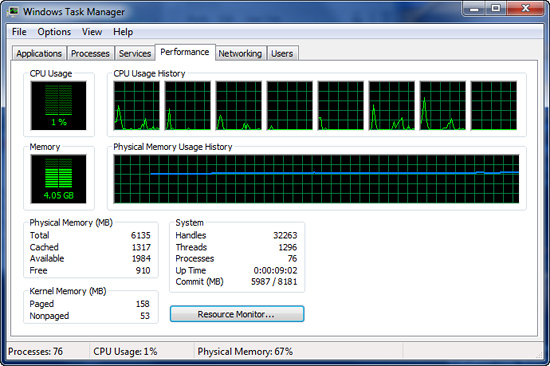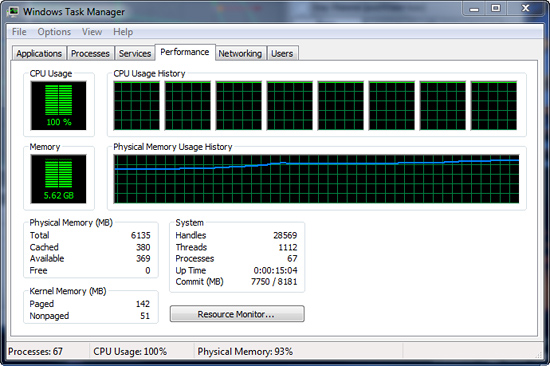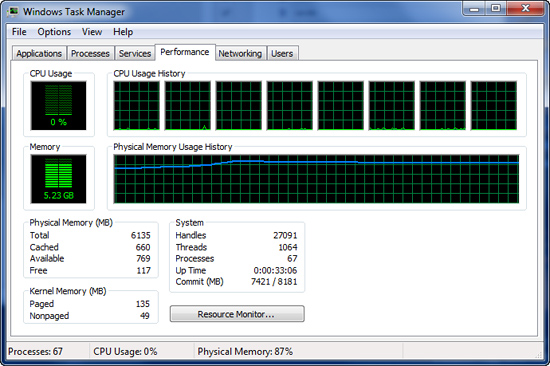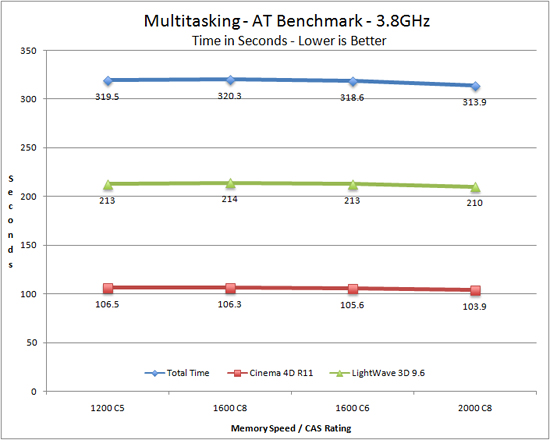Memory Scaling on Core i7 - Is DDR3-1066 Really the Best Choice?
by Gary Key on June 24, 2009 9:00 AM EST- Posted in
- Memory
Heavy Multitasking: The Other Safe Haven for Faster Memory
The vast majority of our benchmarks are single task events that utilize anywhere from 23MB up to 1.4GB of memory space during the course of the benchmark. Obviously, this is not enough to fully stress test our 6GB memory configuration. We devised a benchmark that would simulate a typical home workstation and consume as much of the 6GB as possible without crashing the machine.
We start by opening two instances of Internet Explorer 8.0 each with six tabs opened to flash intensive websites followed by Adobe Reader 9.1 with a rather large PDF document open, and iTunes 8 with The Who blaring loudly. We then open two instances of Lightwave 3D 9.6 with our standard animation, Cinema 4D R11 with the benchmark scene, Microsoft Excel and Word 2007 with large documents, and finally Photoshop CS4 with our test image.

Before we start the benchmark process, our idle state memory usage is 4.05GB. Sa-weet!

We wait two minutes for disk activity to cease and then start playing Pinball Wizard via iTunes, start the render scene process in Cinema 4D R11, start a resize of our Photoshop image, and finally the render frame benchmark in Lightwave 3D. Our maximum memory usage during the benchmark is 5.62GB with 100% CPU utilization across all eight threads.

Our idle memory footprint after the benchmark has completed is 5.23GB. Trying to run our normal Photoshop benchmark at this point resulted in an out of memory error and automatic shutdown of Photoshop CS4 x64.

Our results follow an almost linear scale as we increase memory bandwidth in this benchmark. Improved latencies only matter when combined with increased memory bandwidth for the most part except for the DDR3-1333 C6 results just edging past the DDR3-1600 C9 score.
There is an 8% improvement in the total benchmark score when moving from DDR3-1066 C7 to DDR3-1866 C7. If you multitask with several memory intensive applications, at stock CPU speeds, increasing memory bandwidth is a simple way to improve performance.
Overclocked
Based on the above results at stock CPU speeds, we decided it would be interesting to look at what occurs when we overclock the system. We arrived at a 3.8GHz processor clock speed via the 19x200 setting. Essentially this is a free overclock as our CPU only needed an increase in VTT to 1.35V (board/processor dependent) to handle the increased memory loads at DDR3-1600 C6 and DDR3-2000 C8.

It is not until we hit DDR3-2000 C8 that our system responds favorably to increased memory bandwidth. Even then, the improvement is not as drastic as our stock numbers as going from DDR3-1200 C5 to DDR3-2000 C8 only improves performance by 2%.










47 Comments
View All Comments
sonci - Thursday, June 25, 2009 - link
The title was enough,and yours is too..
goinginstyle - Wednesday, June 24, 2009 - link
I have no idea where you have been hiding Gary but it is great to see you back. I look forward to the AMD article and the individual module tests. If they are half as good as this, I will be one happy person. Any chance or comments on Virtualization benches under WIn7 with XP?duploxxx - Wednesday, June 24, 2009 - link
very nice article with real world applications, now can you pls do the same with amount of dimms used and finally kill this marketing hype?vailr - Wednesday, June 24, 2009 - link
Re:"Current JDEC specifications list 1.50V as the official voltage specification for DDR3 with a move to 1.35V in the near future and eventually to 1.20V."
How does DDR5 (already being used on some video cards) voltages compare with those numbers?
Any predictions on when DDR5 memory modules for main boards might be introduced?
Are lower latency DDR3 modules "in the works"?
Maybe such a thing as:
1333 MHz @4-4-4-12 & 1.20v, for example?
Also: Intel promotes the benefits of using Hafnium when producing their CPU's. Would Hafnium also benefit memory chips?
GourdFreeMan - Thursday, June 25, 2009 - link
The video cards you are thinking of use GDDR, not DDR. You will never find GDDR packaged on DIMMs for motherboard memory slots, but rather only as individual chips for graphics boards and consoles. Though they share some technologies, you would need a different memory controller to make use of it. Typically GDDR5 runs from 1V to 1.4V (the GDDR5 on the stock Radeon HD 4770 runs at 1.263V for example). Hafnium dioxide has already been used by some manufacturers as the dielectric material in DRAM capacitors, and I know NEC, at least, has already used Hafnium in transistor gates for embedded DRAM. As for higher speed and lower latency RAM, that is pretty much always in the works...Zorlac - Wednesday, June 24, 2009 - link
I have thought this all along, but was too lazy to prove it. Thanks Anand!!! :)Any idea when we will start seeing 4GB DIMMs for running 3x4GB kits?
Gary Key - Wednesday, June 24, 2009 - link
We just finished testing a 12GB 1600 C9 kit from Kingston, but the street price is $1400. I also have a 24GB kit from Corsair, but I will not even mention the cost on that one. We should see affordable (compared to buying 6x2GB) 12GB kits later this year in the 1333 C8 variety without ECC. I do have a 12GB ECC Kingston 1066 C8 kit arriving shortly, retail is about $320, to test in some workstation products.DXRick - Wednesday, June 24, 2009 - link
It looks like the sweet spot is 1600 C8 at around $100 for a 6BG kit.vol7ron - Wednesday, June 24, 2009 - link
agreed --- those saying 1333 really are saving the buckI would still like to see SuperPi tests, since they are a mathematical approach to memory performance.
Gary Key - Wednesday, June 24, 2009 - link
Super Pi results will come in Raja's 2000 shootout. However, most of the Super Pi program runs in cache and when it goes outside of it,it only hits a couple of ranks in short bursts (why bandwidth matters) and as a result a proper loading of the entire memory subsystem is not really tested thoroughly. That said, we will have a complete subsection on Super Pi for the overclocking crowd. :)